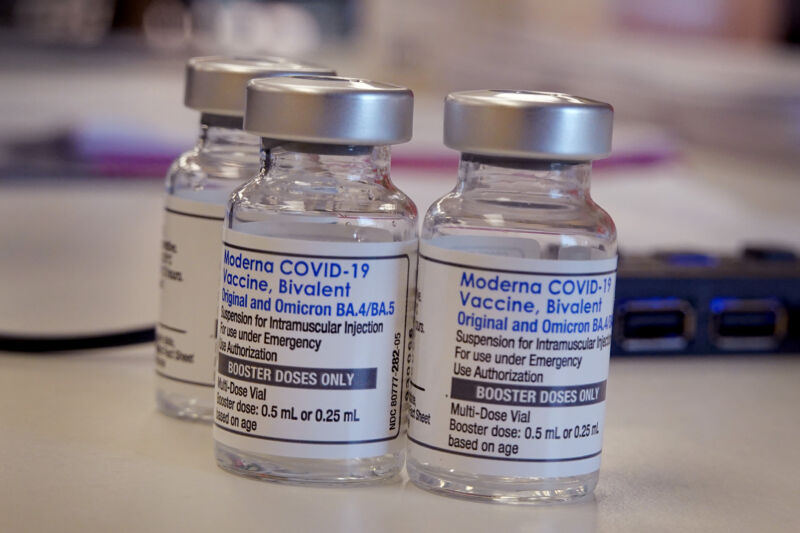In mice, the BA.5-targeting bivalent booster now rolling out nationwide did an equally good job at thwarting the BA.5 omicron subvariant as the bivalent booster targeting its predecessor, BA.1, which US regulators passed on.
That's according to a pre-print study—which hasn't been peer-reviewed or formally published—authored by researchers at Moderna and Washington University School of Medicine.
Although the study is still a preprint and only involved mice, it provides some of the first head-to-head data comparing the two omicron-targeting booster options considered for this fall—one of which is currently going into arms across the US. And the findings may raise questions about the US booster strategy.
Booster decisions
Over the summer, the US Food and Drug Administration—under advisement of its independent expert committee—decided to pass on authorizing the omicron BA.1-targeting bivalent COVID-19 booster. The formula was the farthest along in the development of an omicron-targeting booster and had human clinical data at a time when regulators were scrambling to make decisions and begin dose manufacturing at scale for the nationwide booster campaign this fall.
But even in the summer, BA.1 was already long gone. BA.1 was the first version of omicron that swept across the US, causing a towering wave of infection in January and February this year.
But, by June, when the FDA was making decisions, BA.1 was no longer circulating, and two omicron subvariants, BA.2 and BA.2.12.1, had already swept through. BA.5 and BA.4 were on the rise. The FDA, with the majority of its advisers, wanted to target the leading edge of SARS-CoV-2's evolution, so it set its crosshairs on BA.4 and BA.5, which share the same spike protein. And BA.5 currently accounts for an estimated 87.5 percent of US infections
The sticking point was that there was no human clinical data on a BA.4/5-targeting booster when the FDA authorized the shots at the end of August—and even now as the doses are being administered. While preliminary mouse data suggested a BA.4/5-targeting booster could boost antibodies against BA.4/5, there wasn't clear data comparing how the BA.4/5-targeting bivalent booster fared compared to the more developed BA.1-targeting booster. The FDA expected the BA.4/5-targeting booster would be better at protecting against BA.5 than the BA.1-targeting booster—but they didn't have clear evidence for that. Some experts, including one of the FDA advisers, were critical of the decision to move forward without a clinical trial or data indicating that the BA.4/5 booster would be better than the BA.1 booster.
New mouse data
That's where the new mouse data comes in. In experiments with mice vaccinated with the original COVID-19 vaccines, researchers compared different boosters given seven months after the initial series. The booster options included the original vaccine, the BA.1-targeting bivalent vaccine, and the BA.4/5-targeting bivalent vaccine. There was also an unboosted control group and a sham booster group, which got an injection of a buffer solution.
The two bivalent vaccines increased mouse neutralizing antibodies against BA.1 and BA.5 significantly more than a third shot of the original vaccine. But, both BA.1- and BA.4/5-targeting formulas generated fairly similar levels of neutralizing antibodies against both omicron subvariants.
A month after the booster, researchers challenged the mice with an intranasal BA.5 exposure. Again, both bivalent boosters offered better protection against infection and lung inflammation than a boost with the original vaccine. But among the two bivalent boosters, there wasn't a clear winner.
The authors note in the conclusion:
Our experiments show that two bivalent mRNA vaccines including components against BA.1 or BA.4/5 had relatively equivalent protective effects against BA.5 in the lungs. Although there is a trend towards lower levels of BA.5 RNA after boosting with [the BA.4/5-targeting bivalent booster] compared to [the BA.1-targeting bivalent booster], our studies were not powered sufficiently to establish this increased protection, and larger cohorts would be needed to reach this conclusion.
Lingering uncertainty
Overall, the authors conclude that the data support the decision to roll out both bivalent vaccines. Though the FDA passed on the BA.1-targeting booster, other countries, including the UK, have begun rolling it out.
The authors also note that the study has many limitations, including being in mice, which are notoriously not equivalent to humans. The study also didn't look at how long the protection seen in the mice lasted or how other components of their immune responses, such as cross-reactive T cell responses, were influenced by the boosters.
But for now, the jury is still out on whether the BA.4/5-targeting booster will outcompete the BA.1-targeting booster and whether the FDA was wise to pass on authorizing the BA.1-targeting booster earlier this summer.



3175x175(CURRENT).thumb.jpg.b05acc060982b36f5891ba728e6d953c.jpg)

Recommended Comments
There are no comments to display.
Join the conversation
You can post now and register later. If you have an account, sign in now to post with your account.
Note: Your post will require moderator approval before it will be visible.